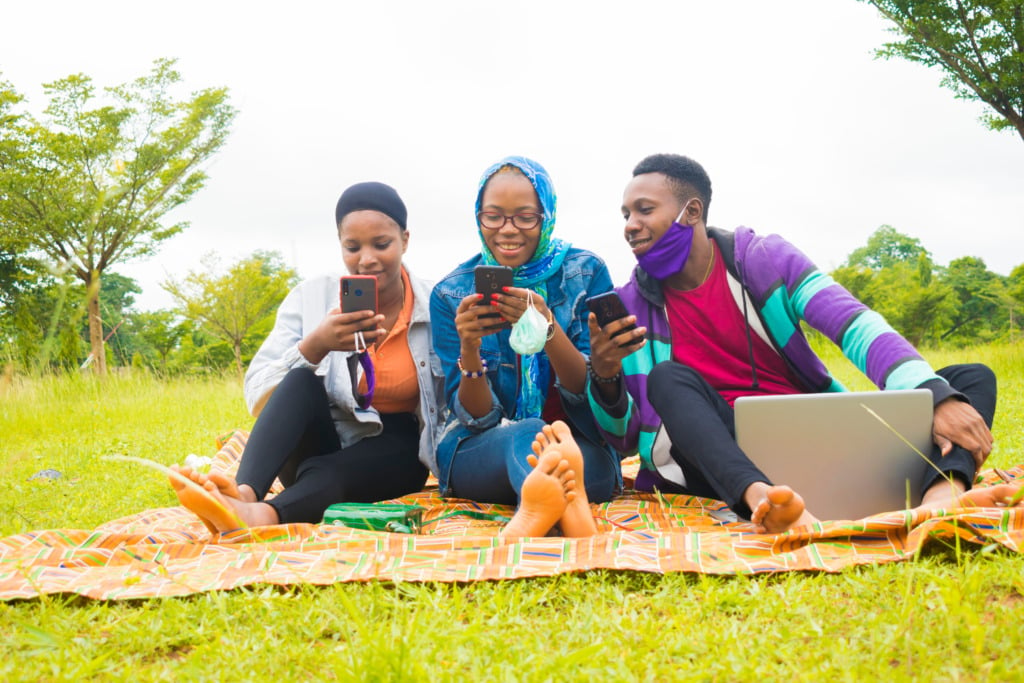Accessing the internet through desktop or laptop computers has not been an option for people in Africa, owing to cost and availability. For that reason, the mobile phone has been the primary tool for accessing internet on the continent. As mobile becomes the pre-eminent platform for digital services in the world, what seemed like a challenge is likely to place Africa in an advantageous position.
What is required is increased access to devices, improved network coverage, more affordable data services, digital education and localised content and services for users on the continent, as it seeks to bridge the digital gap.
A white paper from the United Kingdom Department for International Trade titled “The rise of Africa’s digital economy – tackling the ‘usage gap’ to create a thriving market for mobile services” assesses these issues and offers some recommendations on how Africa and African users can be brought further into the digital mainstream. The report also emphasises the United Kingdom’s support for efforts to expand access to and use of digital services in Africa, including education, entertainment and health services.
Opportunities for mobile services
African consumers, along with others in the rest of the world, have made a rapid shift to mobile services. Unlike in other regions where access is largely through mobile applications, however, the majority of African users tend to access digital services through diverse platforms that suit their budgets and devices. These include mobile network operator (MNO) portals through which service providers can provide zero-rated content and services and direct to consumer short codes where consumers engage with services through a short code.
Third-party portals are another option open to African consumers. An example is the Opera Mini browser which, in partnership with at least 10 MNOs, allows users to access services within the browser with minimum data consumption. Similar to this are the KaiStore, an app store for devices on that platform and mobile money wallets, such as M-Pesa’s “super app”, which gives users access to mini apps.
In addition to these efforts, more innovation will be needed to overcome other unique challenges. For example, the multiplicity of languages requires developers to think creatively about how to accommodate them on their applications. Developers may also rely on voice recognition or they may focus on graphics and images and de-emphasise language. This can add further value where simplicity and digital literacy needs to be addressed.
Other publishers, such as Telecoming, allow users to switch languages while using their services. Developers will have to recognise the diversity of the market as well as the fragmentation in channels of access and build their products to reflect these dynamics.
The evidence is that the digital market is growing rapidly in Africa. Digital Identity management is a key enabler here. In South Africa, the subscription-based economic model is currently worth $530m and is set to grow 14% a year to reach $820m in 2025. Netflix is available in all countries and has recently launched a mobile-only subscription options for users in the continent. Some 4.89m Africans currently subscribe to video-on-demand services and it is expected that number could rise to 13.72m by 2027.
Local operators including Showmax and iROKOTV are also growing, while mobile service providers such as Safaricom and Globacom have launched streaming services and others such as Airtel, Globacom, MTN, Orange, Safaricom and Vodacom are also engaged in the space.
Pandemic-era measures brought the focus on e-learning. The market was estimated to be $2.47bn in 2021, according to a report from the IMARC Group, and is expected to hit $4.71bn by 2027. The report contends that e-learning is meeting the challenge posed by the growing need for quality education, which classroom teaching cannot fully address. Mobile services will instrumental in expanding access to these services.
Barriers to access
African innovators have embraced the opportunities of mobile to present services and content to users. In Kenya, water supply company Davis and Shirtliff has teamed up with 4R Digital, a digital services provider to embed mobile payments on their platforms so users can pay by usage, instead of a prohibitive upfront payment.
Others, like Ubongo, Showmax and iROKOTV are providing entertainment to an increasing number of users. The United Nations Conference on Trade and Development (UNCTAD) estimates that digital services could add an extra $180bn to Africa’s GDP by 2025. However, this could be impeded by barriers to access that persist on the continent.
Access to coverage is one of these barriers. While it is improving around the world it is still an issue in sub-Saharan Africa, where 47% of the world’s uncovered population resides. However, the number of users with access to mobile internet is now 28%, double the number that had access in 2014. Complementary satellite services may add further coverage in the future.
Mobile network operators are working to improve this by rolling out 3G and 4G networks in West Africa. The inability to read or write also prevents a lot of people on the continent from experiencing digital content and services. Other users also struggle to discover and engage with digital services due to their lack of know-how. In response to this the GSM Association has introduced a GSMA Mobile Internet Skills Training Toolkit, which uses PDF and video to provide digital training and can be adapted to local situations.
The cost of devices can be a disincentive to the adoption of digital services but handset makers are working to reduce costs and innovate with targeted devices for the African market. Users have the option of smart feature phones with an operating system that supports third-party apps formatted for smaller screens.
One of these is KaiOS, an operating system hosted on feature phones, which provides users with lightweight applications that enable them to access a wide range of tools and services. Other users can procure budget smartphones from companies like Transsion, the Chinese company behind Itel, Tecno, and Infinix. Refurbished phones from abroad also allow users the chance to access smart devices at a lower price point. Other efforts include using digital technology to extend hire purchase arrangements to consumers, to enable them to pay in instalments.
The lack of localised content also constitutes a barrier, as users my not engage with content that is not tailored to them. Providing content in local language and which require less data will enable more people to engage. For content and service providers, inefficient or inaccessible payment channels can make it difficult to monetise their offerings.
Mobile money services, the GSMA’s Mobile Money API and digital carrier billing are some of the options that providers have to address this. The high cost of smart devices and data services is another challenge. While services based on USSD and SMS have been delivered to feature phone users, smartphone usage must also be increased to expand digital opportunities. Combined efforts from KaiOS, Opera, Safari9com, Google and MNOs are helping to reduce costs.
Payment channels enable skills
Reliable payments channels are essential for digital services to thrive. In Africa, where a lot of the population are unbanked and economies are largely cash-based, this would have been a major challenge without the emergence of mobile money and direct carrier billing. There are about 1.35bn money accounts in the world currently, most of them in Africa. In 2021, about $1 trillion in transactions were carried out over these platforms. Payments to merchants are increasing, accounting for an average of $5.5bn in transactions a month, up from $2.8bn in 2020.
However, the GSMA’s Global Adoption Survey found that more than 90% of providers do not have this feature, while merchant payments are still predominantly offline. Among the efforts to increase usage is the GSMA’s Mobile Money API, developed in collaboration with industry players that seeks to simply and accelerate integration with third-party providers. Intermediaries such as Ireland’s Tola and Nigeria’s Flutterwave are also assisting merchants to accept and process mobile money payments. Kenyan mobile money provider M-Pesa has launched an app that enables users to connect with other services on the platform, which has already been downloaded by 8m users.
Direct carrier billing (DCB), whereby consumers charge goods and services to their mobile phone bill, is another growing payment channel. Telecoming, a content specialist, estimates that $89m will be charged through DCB in South Africa in 2022. It expects 16% in year-on-year growth, culminating in $159m by 2026. Currently, DCB payments are mainly for videos, music and games but it is spreading to other markets such as ticketing (Telecoming predicts that it will be account for $7m in ticket sales this year) and even physical goods.
Africa has unique challenges with education provision. While governments spend an average of 5% of GDP and 16% of national budgets on education, the continent scores 58% and 41% efficiency for primary and secondary education respectively, according to Brookings.
Africa’s mobile learning market
For this reason, it is believed that education technology, utilising mobile platforms, offers a great opportunity for the continent to expand access and improve quality. According to the IMARC Group, the market in African edtech reached $2.47bn in 2021 and could be worth $4.71bn by 2017. Meanwhile, the total global market is estimated to be $404bn by 2025.
Edtech has several advantages that are suitable for Africa. It delivers widely available and cost-effective solutions, especially in countries that do not have adequate tools and resources for educating young people. It is also a path to acquiring important digital skills for young people, which will become very crucial as more people are expected to require digital skills to survive in the rapidly changing global job market.

As of September, 2022, EdTech Hub, which monitors the industry, lists 210 firms providing edtech services in Africa. However, it observes that the industry is unstructured and incoherent, with little focus on how investments by these firms will work, when they will, how much will be needed and the context in which the investments will work.
Some of the providers in the market are M-Shule, a Kenyan service that combines SMS with artificial intelligence to provide offline or low-income communities with mobile learning tools; Ubongo, which provides mainly cartoon programming for children; Viamo, into which people can dial in and listen to important information such as public health messages; and EdoBEST, which provides educational resources via audio lessons, digital self-study activity packets, digital storybooks, mobile interactive quizzes, learning guides for parents, and virtual classrooms.
Others are African Story Book, which works with local educators to publish books that can be read online or offline, or downloaded and printed; Worldreader, which gives readers access to one of the largest catalogues of free eBooks via the Opera Mini browser; and Funzi, which specialises in gamified, bite-sized lessons offered via community partners, non-governmental organizations, MNOs and social networks.
Conclusions and recommendations
Mobile services have the power to transform societies by eliminating the challenges of time and distance. Not only do they have to deliver beneficial services such as educational technology, they also bring entertainment and can create jobs and increase revenue generation. According to the United Nations, internet business in Africa could add $180bn to the continent’s GDP by 2025. To get to these benefits, industry stakeholders will need to work together to address structural barriers such as reach and the usage gap. Measures such as education, cheaper devices, affordable data services and content that is targeted at and adapted to the needs and circumstances of the African consumer will have be applied to help the market reach its full potential. The United Kingdom government is confident that a coordinated approach from mobile operators, regulators and mobile content creators can achieve the goal of increased access and usage in Africa. The UK also recognises the immense potential of the mobile to transform lives and societies in Africa and is committed to working with its counterparts to stimulate digital innovation on the continent. A more robust digital economy will give African businesses and citizens access to more functional mobile channels which will promote more commerce and, eventually, strong economic growth.
Dr Mike Short CBE is Chief Scientific Adviser to the UK Government’s Department for International Trade.



